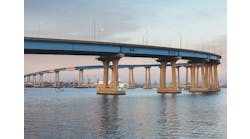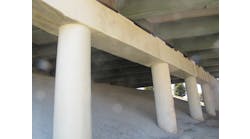The Texas Department of Transportation (TxDOT) decided to investigate the feasibility of using fiber-reinforced polymer (FRP) composite materials for new highway structures. Primary FRP structural beams for short-span bridges near the Gulf Coast were identified as a promising application. These bridges span bayous, drainage ditches and saltwater inlets. The installations are subject to severe corrosion attack because of factors such as high humidity, salt air, salt and brackish water and poor drainage. Steel, timber and concrete have all exhibited corrosion-induced degradation in this environment.
In addition to investigating the feasibility of different structural systems, the project addressed cost-effective methods of implementing FRP in bridge structural elements.
A call for action
Early in the project, TxDOT identified a key limiting aspect of FRP materials: their relatively low elasticity/tensile modulus. To address this issue, the testing program focused on developing a system combining FRP beams and a conventionally reinforced concrete deck that could effectively sustain traffic loading by means of composite action. Composite action, when the beam and the deck form a high-performance interactive system, is desirable to limit overall deflections. An additional advantage of using a conventionally reinforced concrete deck is that it reduces cost and aids in the distribution of wheel loads across several beams.
At the forefront of the project’s technical and research effort was Sib Banerjee, MFG manager, structural applications, who stated, “Our challenge and goal was to change and improve the cross section of the original beam so it’d be easier to manufacture and designed to eliminate any possibility of movement in the connection. This is vitally important to ensure the effectiveness of the composite action between the concrete and the beam.” Molded Fiber Glass (MFG) teamed with TxDOT to research and develop this “first of its kind” beam. This mutual cooperation of widely experienced material engineers led to the production of the 26 beams needed for the San Patricio County bridge. All testing was done in-house at the MFG Research Lab and the beams were produced at MFG West’s 68,000-sq-ft facility in Adelanto, Calif.
The following criteria describe the successful completion of the job:
- Manufacturing and quality control were required to meet ASME RTP-1 specifications;
- Qualification was required of both the manufacturing facility and of the individuals laminating the parts;
- A change was made in regard to the original cross section of the beam. MFG preferred a uniform cross section. Detailed finite element analysis and hand calculations were made for TxDOT approval;
- Tests were made to produce the desired uniform thickness from a combination of biaxial stitched fabric with 1.5-oz. chopped-glass architecture;
- For laminate properties, a representative architecture was used for producing laminate thickness to derive tensile modulus, tensile strength, in-plane shear and bearing strength as required by TxDOT specifications;
- Connection of the brace bars, which transfer loads from the concrete deck to the composite beam, was critically addressed and an insert was designed to be embedded in the laminate with the inside diameter accepting the outer diameter of the brace bar;
- MFG produced 26 beams. TxDOT personnel tested and passed four of the beams using the acoustic emission procedure per sections V and X of the ASME Code. Based on this sampling and the ASME RTP-1 procedures, all 26 beams were accepted with 24 required for the installation; and
- During load testing, measured deflection was approximately 0.048 in. at design HS-20 loading. This was barely 11% of 0.435 in., the L/800 maximum for a 29-ft-span bridge, demonstrating the high level of composite action that was achieved.
Banerjee noted the process strategy, stating, “We achieved our goal through finite element analysis between the geometric shape and material properties to prove that the low deflection requirement was met (L/800=normal). This is done hand-in-hand with analyzing the glassply schedule to optimize the modulus.”
Accepted alternative
TxDOT initiated research to explore the potential for use of FRP as an alternative structural material. The San Patricio County bridge was designed and built as a step toward optimizing the potential of FRP in bridge structures. It is not only the first of its kind, but also is an important step in the successful implementation of FRP materials in future infrastructure applications.
Ronnie Medlock, TxDOT bridge technical services director, indicated they had explored FRP use in bridges and other transport applications for many years, recognizing it as an excellent structural material for corrosion and durability, yet were concerned about its deflection under load. Medlock noted the project’s success in overcoming the deflection issue, stating, “Load tests performed showed deflections of less than 1?16 on 30-ft-span beams, far exceeding our requirements.”
“MFG and TxDOT combined forces and designed a connection that properly transmitted the horizontal shear from the concrete deck to the composite beam, eliminating any possibility of movement in the connection,” Banerjee said.


